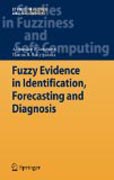
Fuzzy evidence in identification, forecasting anddiagnosis
Rotshtein, Alexander P.
Rakytyanska, Hanna B.
The purpose of this book is to present a methodology for designing and tuningfuzzy expert systems in order to identify nonlinear objects; that is, to build input-output models using expert and experimental information. The results of these identifications are used for direct and inverse fuzzy evidence in forecasting and diagnosis problem solving. The book is organised as follows: Chapter 1 presents the basic knowledge about fuzzy sets, genetic algorithms and neural nets necessary for a clear understanding of the rest of this book. Chapter2 analyzes direct fuzzy inference based on fuzzy if-then rules. Chapter 3 is devoted to the tuning of fuzzy rules for direct inference using genetic algorithms and neural nets. Chapter 4 presents models and algorithms for extracting fuzzy rules from experimental data. Chapter 5 describes a method for solving fuzzy logic equations necessary for the inverse fuzzy inference in diagnostic systems. Chapters 6 and 7 are devoted to inverse fuzzy inference based on fuzzyrelations and fuzzy rules. Chapter 8 presents a method for extracting fuzzy relations from data. All the algorithms presented in Chapters 2-8 are validatedby computer experiments and illustrated by solving medical and technical forecasting and diagnosis problems. Finally, Chapter 9 includes applications of the proposed methodology in dynamic and inventory control systems, prediction ofresults of football games, decision making in road accident investigations, project management and reliability analysis.. . Original research devoted to the resolution of the direct and inverse problems of fuzzy inference with the use of genetic and neural algorithms. They described a model to solve inverse problems of fuzzy inference and present some applications of this model. Written by leading experts in the field INDICE: Preface. Fundamentals of intellectual technologies. Direct inference based on fuzzy rules. Fuzzy rules tuning for direct inference. Fuzzy rules extraction from experimental data. Inverse inference based on fuzzy relationalequations. Inverse inference with fuzzy relations tuning. Inverse inference based on fuzzy rules. Fuzzy relations extraction from experimental data. Applied fuzzy systems.
- ISBN: 978-3-642-25785-8
- Editorial: Springer Berlin Heidelberg
- Encuadernacion: Cartoné
- Páginas: 330
- Fecha Publicación: 31/01/2012
- Nº Volúmenes: 1
- Idioma: Inglés
